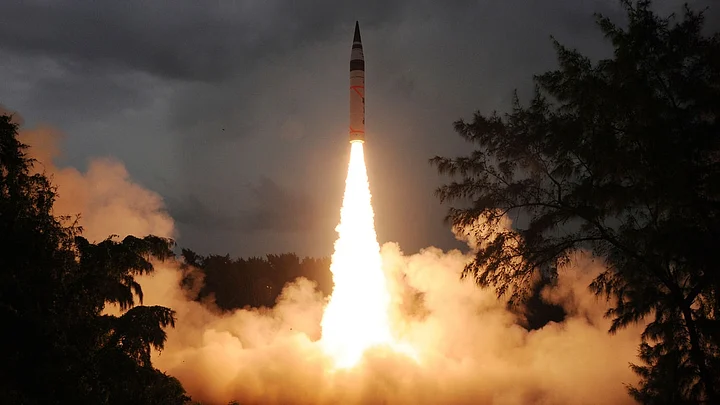It was amusing to read about the Pakistani Prime Minister trying to rattle the nuclear sabre yet again when he spoke about his country having developed short range nuclear weapons as a counter to India's Cold Start Doctrine.
Amusing, because a new prime minister repeating a threat as old as that is meaningless. One wonders whether successive prime ministers of Pakistan simply believe the tripe that the Pakistan Army feeds them, or they just play their role in perpetuating the myth, despite knowing better.
The Cold Start Doctrine
For the uninitiated, Indian strategic planners formulated the Cold Start Doctrine after the stalemate resulting from Operation Parakram.
It may be recalled that in this operation, India mobilised its forces in reaction to the 13 December 2001 terrorist attack on the Parliament.
For a few tense weeks, the world watched the two nuclear armed powers teetering on the brink of war while world leaders worked back channels to diffuse the situation. By the end of January, it was clear that the immediate danger of war was over, but the border deployment of forces continued for almost another year.
Despite face-saving arguments of having achieved its strategic objectives, the futility of the exercise was not lost on Indian planners, and thus, the Cold Start Doctrine emerged as an alternate response to any future provocations like the Parliament attack.
Also Read: Why War With Pakistan Is Not an Option
Ideal Low Cost Option for Pakistan
The doctrine envisages the Indian Army rapidly mobilising from forward peacetime bases and, instead of moving into a ‘war ready’ posture close to the border as during Parakram, crossing the border and advancing as far into Pakistani territory as a surprise would carry them before Pakistan can put together a viable resistance.
The idea is to shorten the time taken by key formations to launch themselves into battle, as well as the decision time to launch them, in order to take precipitate action before international intervention can kick in to mediate.
This actively counters Pakistani strategy of “keeping the pot boiling", ie, keeping India tied down through low level proxy war without allowing escalation into a full-fledged conventional conflict. This is an ideal low cost option for Pakistan given India's edge in conventional war waging capability.
Thus, as a foil to this rapid escalation doctrine, Pakistan came up with the Short Range (or Tactical) Nuclear Weapon story, the gist of which is that Pakistan has developed ‘small’, short-range nuclear weapons, which it will not hesitate to use in case of a sudden invasion of its territory.
Unfortunately for them, this plan has quite a few holes.
Loopholes in Tactical Nuclear Weapon Plan
The first hole is the premise itself – that they would be justified in using the nuclear weapon in their own territory, against invading military forces, and as such India may have second thoughts about launching a retaliatory nuclear strike. India has declared a 'no first use' nuclear weapons policy, but its doctrine also talks about 'massive retaliation' in any such situation, the cost of which would be prohibitive to Pakistan.
The second hole is the minimal impact of such Tactical Nuclear Weapons on advancing of Indian forces. Indian strike forces advancing into Pakistan in such a scenario would be mechanized columns – tanks and Infantry Combat Vehicles.
Not only are these protected from NBC (Nuclear-Biological-Chemical) attacks, their ‘vast spread’ when they move in battle formations means that just a handful of these would fall into the area over which a single Tactical Nuclear Weapon would be effective.
To give a rough idea, there would be approximately three tanks over a one-kilometre frontage of a column.
There would be multiple columns advancing along hundreds of kilometres and a single tactical device may at best knock out a couple of tanks in the immediate vicinity of the actual blast.
So how many such devices does Pakistan have, and how would they be able to use within the short window available?
A ‘Death Wish’ Only Pakistan Can Have
The third, and most ominous hole (for Pakistan) is the soup it will be putting itself into internationally, by choosing to be the initiator of a nuclear weapons attack. Irrespective of whether India responds in kind subsequently, Pakistan would certainly face crippling sanctions for doing so.
And lastly, the fourth hole is the long term ecological impact of the immediate and residual effects of using nuclear weapons within its own territory that Pakistan will have to deal with once the dust settles.
Interestingly, the above is the ‘best case’ scenario for Pakistan, and things would only get trickier in any variations – for example, if it decides to launch the weapons at the launch pads or logistic bases of the advancing forces, located within Indian territory.
In short, using a Tactical Nuclear Weapon to counter the Cold Start Strategy would not cause any substantial damage to Indian offensive forces, yet leave Pakistan open to massive retaliatory strikes by India and crippling international sanctions.
The threat, therefore, is either a deterrent that Pakistan hopes would prevent India from putting Cold Start into action, or a death wish that only Pakistan can have.
(The writer is a retired colonel of the Indian army and currently a research fellow at the Ministry of Defence, writing the official history of India’s participation in World War I. He can be reached at @ragarwal. This is an opinion piece and the views expressed above are the author’s own. The Quint neither endorses nor is responsible for the same.)
